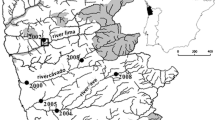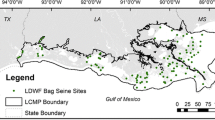Abstract
Species distribution models combining environmental and spatial components are increasingly used to understand and forecast species invasions. However, modelling distributions of invasive species inhabiting stream networks requires due consideration of their dendritic spatial structure, which may strongly constrain dispersal and colonization pathways. Here we evaluate the application of novel geostatistical tools to species distribution modelling in dendritic networks, using as case study two invasive crayfish (Procambarus clarkii and Pacifastacus leniusculus) in a Mediterranean watershed. Specifically, we used logistic mixed models to relate the probability of occurrence of each crayfish to environmental variables, while specifying three spatial autocorrelation components in random errors. These components described spatial dependencies between sites as a function of (1) straight-line distances (Euclidean model) between sites, (2) hydrologic (along the waterlines) distances between flow-connected sites (tail-up model), and (3) hydrologic distances irrespective of flow connection (tail-down model). We found a positive effect of stream order on P. clarkii, indicating an association with the lower and mid reaches of larger streams, while P. leniusculus was affected by an interaction between stream order and elevation, indicating an association with larger streams at higher altitude. For both species, models including environmental and spatial components far outperformed the pure environmental models, with the tail-up and the Euclidean components being the most important for P. clarkii and P. leniusculus, respectively. Overall, our study highlighted the value of geostatistical tools to model the distribution of riverine and aquatic invasive species, and stress the need to specify spatial dependencies representing the dendritic network structure of stream ecosystems.




Similar content being viewed by others
References
Allan JD, Castillo MM (2007) Stream ecology: structure and function of running waters, 2nd edn. Springer, Dordrecht
Altermatt F (2013) Diversity in riverine metacommunities: a network perspective. Aquat Ecol 47:365–377
Anastácio PM, Banha F, Capinha C, Bernardo JM, Costa AM, Teixeira A, Bruxelas S (2015) Indicators of movement and space use for two co-occurring invasive crayfish species. Ecol Indic 53:171–181
Bernardo JM, Costa AM, Bruxelas S, Teixeira A (2011) Dispersal and coexistence of two non-native crayfish species (Pacifastacus leniusculus and Procambarus clarkii) in NE Portugal over a 10-year period. Knowl Manag Aquat Ecosyst 401:28
Bronnenhuber JE, Dufour BA, Higgs DM, Heath DD (2011) Dispersal strategies, secondary range expansion and invasion genetics of the nonindigenous round goby, Neogobius melanostomus, in Great Lakes tributaries. Mol Ecol 20:1845–1859
Capinha C, Anastácio P (2011) Assessing the environmental requirements of invaders using ensembles of distribution models. Divers Distrib 17:13–24
Capinha C, Brotons L, Anastácio P (2013) Geographical variability in propagule pressure and climatic suitability explain the European distribution of two highly invasive crayfish. J Biogeogr 40:548–558
Carrara F, Altermatt F, Rodriguez-Iturbe I, Rinaldo A (2012) Dendritic connectivity controls biodiversity patterns in experimental metacommunities. Proc Natl Acad Sci USA 109:5761–5766
Clavero M (2016) Species substitutions driven by anthropogenic positive feedbacks: Spanish crayfish species as a case study. Biol Cons 193:80–85
Cressie NA (1993) Statistics for spatial data, Revised edn. Wiley, New York
Cruz MJ, Rebelo R (2007) Colonization of freshwater habitats by an introduced crayfish, Procambarus clarkii, in Southwest Iberian Peninsula. Hydrobiologia 575:191–201
De Marco P, Diniz-Filho JAF, Bini LM (2008) Spatial analysis improves species distribution modelling during range expansion. Biol Lett 4:577–580
Diniz-Filho JAF, Bini LM, Hawkins BA (2003) Spatial autocorrelation and red herrings in geographical ecology. Glob Ecol Biogeogr 12:53–64
ESRI (2011) ArcGIS Desktop: Release 10.2. Environmental Systems Research Institute, Redlands, CA
Ferreira M, Filipe AF, Bardos DC, Magalhães MF, Beja P (2016) Modeling stream fish distributions using interval-censored detection times. Ecol Evol 6:5530–5541
Filipe AF, Magalhães MF, Collares-Pereira MJ (2010) Native and introduced fish species richness in Mediterranean streams: the role of multiple landscape influences. Divers Distrib 16:773–785
Frieden JC, Peterson EE, Webb JA, Negus PM (2014) Improving the predictive power of spatial statistical models of stream macroinvertebrates using weighted autocovariance functions. Environ Model Softw 60:320–330
Gherardi F, Aquiloni L, Diéguez-Uribeondo J, Tricarico E (2011) Managing invasive crayfish: is there a hope? Aquat Sci 73:185–200
Gramer M, Lemon J, Fellows I, Singh P (2012) Various coefficients of interrater reliability and agreement. https://cran.r-project.org/web/packages/irr/irr.pdf
Grant EHC, Nichols JD, Lowe WH, Fagan WF (2010) Use of multiple dispersal pathways facilitates amphibian persistence in stream networks. Proc Natl Acad Sci USA 107:6936–6940
Guan RZ (1994) Burrowing behaviour of signal crayfish, Pacifastacus leniusculus (Dana), in the river Great Ouse, England. Freshw Forum 4:155–168
Habsburgo-Lorena AS (1978) Present situation of exotic species of crayfish introduced into Spanish continental waters. Freshw Crayfish 4:175–184
Hänfling B, Edwards F, Gherardi F (2011) Invasive alien Crustacea: dispersal, establishment, impact and control. Biocontrol 56:573–595
Hein CL, Öhlund G, Englund G (2011) Dispersal through stream networks: modelling climate-driven range expansions of fishes. Divers Distrib 17:641–651
Hughes RM, Kaufmann PR, Weber MH (2011) National and regional comparisons between Strahler order and stream size. J N Am Benthol Soc 30:103–121
Jackson AL (2011) Renewable energy vs. biodiversity: policy conflicts and the future of nature conservation. Glob Environ Chang 21:1195–1208
Larson ER, Olden JD (2012) Using avatar species to model the potential distribution of emerging invaders. Glob Ecol Biogeogr 21:1114–1125
McGuire KJ, Torgersen CE, Likens GE, Buso DC, Lowe WH, Bailey SW (2014) Network analysis reveals multiscale controls on streamwater chemistry. Proc Natl Acad Sci USA 111:7030–7035
Moreira FD, Ascensão F, Capinha C, Rodrigues D, Segurado P, Santos-Reis M, Rebelo R (2015) Modelling the risk of invasion by the red-swamp crayfish (Procambarus clarkii): incorporating local variables to better inform management decisions. Biol Invasions 17:273–285
Peterson EE, Ver Hoef JM (2010) A mixed-model moving-average approach to geostatistical modeling in stream networks. Ecology 91:644–651
Peterson EE, Ver Hoef JM (2014) STARS: an ArcGIS toolset used to calculate the spatial information needed to fit spatial statistical models to stream network data. J Stat Softw 56:1–17
Peterson EE, Theobald DM, Ver Hoef JM (2007) Geostatistical modelling on stream networks: developing valid covariance matrices based on hydrologic distance and stream flow. Freshw Biol 52:267–279
Peterson EE, Ver Hoef JM, Isaak DJ, Falke JA, Fortin MJ, Jordan CE, McNyset K, Monestiez P, Ruesch AS, Sengupta A, Som N, Steel EA, Theobald DM, Torgersen CE, Wenger SJ (2013) Modelling dendritic ecological networks in space: an integrated network perspective. Ecol Lett 16:707–719
Quaglietta L, Fonseca VC, Mira A, Boitani L (2014) Sociospatial organization of a solitary carnivore, the Eurasian otter (Lutra lutra). J Mammal 95:140–150
R Core Team (2014) R: a language and environment for statistical computing. R Foundation for Statistical Computing, Vienna, Austria. http://www.R-project.org/
Rallo A, García-Arberas L (2002) Differences in abiotic water conditions between fluvial reaches and crayfish fauna in some northern rivers of the Iberian Peninsula. Aquat Living Resour 15:119–128
Ramalho RO, Anastácio PM (2015) Factors inducing overland movement of invasive crayfish (Procambarus clarkii) in a ricefield habitat. Hydrobiologia 746:135–146
Ramos MA, Pereira TM (1981) Um novo Astacidae para a fauna portuguesa: Procambarus clarkii (Girard, 1852). Boletim do Instituto Nacional de Investigação Pescas, Lisboa 6:37–47
Robin X, Turck N, Hainard A, Tiberti N, Lisacek F, Sanchez JC, Müller M (2011) pROC: an open-source package for R and S+ to analyze and compare ROC curves. BMC Bioinform 12:77
Siesa ME, Manenti R, Padoa-Schioppa E, De Bernardi F, Ficetola GF (2011) Spatial autocorrelation and the analysis of invasion processes from distribution data: a study with the crayfish Procambarus clarkii. Biol Invasions 13:2147–2160
Souty-Grosset C, Holdich DM, Noel PY, Reynolds JD, Haffner P (2006) Atlas of crayfish in Europe. Museum National d’ Histoire Naturelle, Paris
Strayer DL (2010) Alien species in fresh waters: ecological effects, interactions with other stressors, and prospects for the future. Freshw Biol 55:152–174
Titus K, Mosher JA, Williams BK (1984) Chance-corrected classification for use in discriminant analysis: ecological applications. Am Midl Nat 111:1–7
Václavík T, Meentemeyer RK (2009) Invasive species distribution modeling (iSDM): are absence data and dispersal constraints needed to predict actual distributions? Ecol Model 220:3248–3258
Václavík T, Meentemeyer RK (2012) Equilibrium or not? Modelling potential distribution of invasive species in different stages of invasion. Divers Distrib 18:73–83
Václavík T, Kupfer JA, Meentemeyer RK (2012) Accounting for multi-scale spatial autocorrelation improves performance of invasive species distribution modelling (iSDM). J Biogeogr 39:42–55
Ver Hoef JM, Peterson EE (2010) A moving average approach for spatial statistical models of stream networks. J Am Stat Assoc 105:6–18
Ver Hoef JM, Peterson EE, Theobald D (2006) Spatial statistical models that use flow and stream distance. Environ Ecol Stat 13:449–464
Ver Hoef JM, Peterson EE, Clifford D, Shah R (2014) SSN: an R package for spatial statistical modeling on stream networks. J Stat Softw 56(3):1–43. http://www.jstatsoft.org/v56/i03/. Accessed Jan 2015
Vittinghoff E, McCulloch CE (2007) Relaxing the rule of ten events per variable in logistic and Cox regression. Am J Epidemiol 165:710–718
Vogt JV, Soille P, de Jaeger AL, Rimaviciute E, Mehl W (2007) A Pan-European river and catchment database. EC-JRC (Report EUR 22920 EN) Luxembourg. http://desert.jrc.ec.europa.eu/action/documents/CCM2-Report_EUR-22920-EN_2007_STD.pdf. Accessed Jan 2015
Walsh JR, Carpenter SR, Vander Zanden MJ (2016) Invasive species triggers a massive loss of ecosystem services through a trophic cascade. Proc Natl Acad Sci USA 113:4081–4085
Acknowledgements
This work is part of the Baixo Sabor Long Term Ecological Research (LTER) project, funded by Portuguese Science and Technology Foundation (FCT) through LTER/BIA-BEC/0004/2009, and by EDP Energias de Portugal. AFF was supported by the FRESHING Project funded by FCT and COMPETE (PTDC/AAG-MAA/2261/2014 – POCI-01-0145-FEDER-356 016824), and MF was supported by FCT PhD grant SFRH/BD/95202/2013. We thank Pedro Silva, Rita Severino, Sara Ivone and Sérgio Henriques for their collaboration in field work, and Duarte Prata for preliminary analysis of the data.
Author information
Authors and Affiliations
Corresponding author
Electronic supplementary material
Below is the link to the electronic supplementary material.
Rights and permissions
About this article
Cite this article
Filipe, A.F., Quaglietta, L., Ferreira, M. et al. Geostatistical distribution modelling of two invasive crayfish across dendritic stream networks. Biol Invasions 19, 2899–2912 (2017). https://doi.org/10.1007/s10530-017-1492-3
Received:
Accepted:
Published:
Issue Date:
DOI: https://doi.org/10.1007/s10530-017-1492-3




